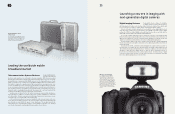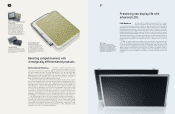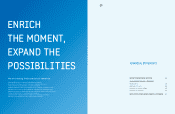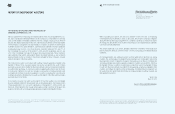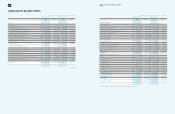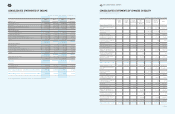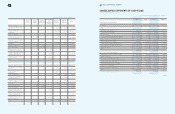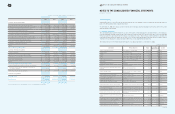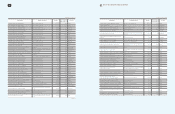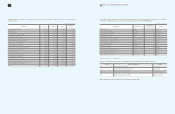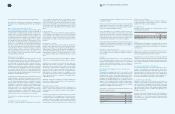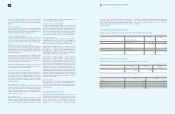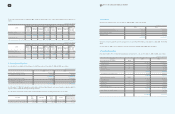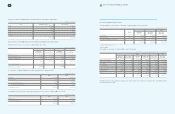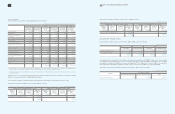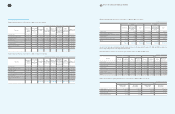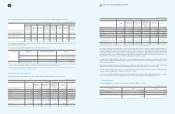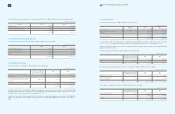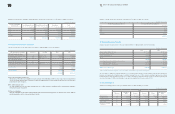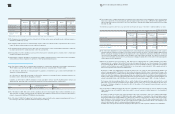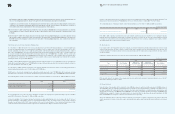Samsung 2009 Annual Report Download - page 29
Download and view the complete annual report
Please find page 29 of the 2009 Samsung annual report below. You can navigate through the pages in the report by either clicking on the pages listed below, or by using the keyword search tool below to find specific information within the annual report.
54 55 NOTES TO THE CONSOLIDATED FINANCIAL STATEMENTS
2. Summary of Significant Accounting Policies
The significant accounting policies followed by the Company in the
preparation of its consolidated financial statements are summarized
below:
Basis of Financial Statement Presentation
The Company maintains its accounting records in Korean won and
prepares statutory financial statements in the Korean language in
conformity with accounting principles generally accepted in the
Republic of Korea. Certain accounting principles applied by the
Company that conform with financial accounting standards and
accounting principles in the Republic of Korea may not conform
with generally accepted accounting principles in other countries.
Accordingly, these financial statements are intended for use by
those who are informed about Korean accounting principles and
practices. The accompanying consolidated financial statements
have been condensed, restructured and translated into English
from the Korean language consolidated financial statements.
Certain information attached to the Korean language consolidated
financial statements, but not required for a fair presentation of
the Company’s financial position, results of operations or cash
flows or changes in equity, is not presented in the accompanying
consolidated financial statements.
Principles of Consolidation
The Company records differences between the investment account
and corresponding capital account of subsidiaries as goodwill
or negative goodwill, and such differences are amortized over
five years using the straight-line method. However, differences
which occur from additional investments acquired in consolidated
subsidiaries are reported in a separate component of equity, and
are not included in the determination of the results of operations.
In accordance with the SKFAS No. 25, Consolidated Financial
Statements, minority interests in consolidated subsidiaries are
presented within equity and identified separately from shareholders’
equity in the consolidated balance sheet.
All significant intercompany transactions and balances have been
eliminated during consolidation. Unrealized profits included in
inventories, property, plant and equipment and other assets, as
a result of intercompany transactions, are eliminated. Unrealized
profit, arising from sales by the controlling company to consolidated
subsidiaries, or equity-method investees, is fully eliminated and
charged to the equity of the controlling company. Unrealized profit,
arising from sales by the consolidated subsidiaries, or equity-
method investees, to the controlling company, or sales between
consolidated subsidiaries, or equity-method investees, is fully
eliminated, and charged to the equity of the controlling company
and minority interest, based on the percentage of ownership.
The SEC and its consolidated subsidiaries follow the same fiscal
year end.
Translation of Foreign Operations
Accounts of foreign subsidiaries are maintained in the currencies
of the countries in which they operate. In translating the foreign
currency financial statements of these subsidiaries into Korean won,
income and expenses are translated at the average rate for the
year and assets and liabilities are translated at the rate prevailing
on the balance sheet date. Resulting translation gains or losses
are recorded as other comprehensive income presented as part of
equity.
Use of Estimates
The preparation of the financial statements requires management
to make estimates and assumptions that affect amounts reported
therein. Although these estimates are based on management’s
best knowledge of current events and actions that the Company
may undertake in the future, actual results may differ from those
estimates.
Investment in Securities
Investments in equity securities or debt securities are classified into
trading securities, available-for-sale securities and held-to-maturity
securities, depending on the acquisition and holding purpose.
Trading securities are classified as current assets while available-for-
sale securities and held-to-maturity securities are classified as long-
term investments, except those securities that mature or are certain
to be disposed of within one year, which are classified as current
assets.
Cost is measured at the market value upon acquisition, including
incidental costs, and is determined using the average cost method.
Available-for-sale securities are stated at fair value, while non-
marketable equity securities are stated at cost. Unrealized holding
gains and losses on available-for-sale securities are reported in
equity under accumulated other comprehensive income, which
are to be included in current operations upon the disposal or
impairment of the securities. In the case of available-for-sale
debt securities, the difference between the acquisition cost after
amortization using the effective interest rate method and the fair
value is reported in equity as a component of accumulated other
comprehensive income.
Impairment resulting from a significant or prolonged decline in fair
value of the security below its acquisition cost, net of amortization is
recognized in current operations.
Equity-Method Investments
Investments in business entities in which the Company has the
ability to exercise significant influence over the operating and
financial policies are accounted for using the equity method of
accounting.
Under the equity method, the original investment is recorded at
cost and adjusted by the Company’s share in the net book value
of the investee with a corresponding charge to current operations,
a separate component of equity, or retained earnings, depending
on the nature of the underlying change in the net book value.
Unrealized profit arising from sales between the Company and
its equity-method investees is eliminated to the extent of the
Company’s ownership.
Differences between the investment amounts and corresponding
capital amounts of the investees at the date of acquisition of the
investment are recorded as part of investments and are amortized
over five years using the straight-line method.
Assets and liabilities of the Company’s foreign investees are
translated at current exchange rates, while income and expense
are translated at average rates for the period. Adjustments resulting
from the translation process are reported as accumulated other
comprehensive income in a separate component of equity, and are
not included in the determination of the results of operations.
Certain equity-method investments are accounted for based on
unaudited or unreviewed financial statements as the audited or
reviewed financial statements of these entities are not available as
of the date of this audit report.
Allowance for Doubtful Accounts
The Company provides an allowance for doubtful accounts and
notes receivable based on the aggregate estimated collectibility of
the receivables.
Inventory
Inventories are stated at the lower of cost or net realizable value.
Cost is determined using the average cost method, except for
materials-in-transit which are stated at actual cost as determined
using the specific identification method. Losses on valuation of
inventories and losses on inventory obsolescence are recorded as
part of cost of sales.
Property, Plant and Equipment, Net of Accumulated
Depreciation
Property, plant and equipment are stated at cost, except for certain
assets subject to upward revaluation in accordance with the Asset
Revaluation Law of Korea. The revaluation presents production
facilities and other buildings at their depreciated replacement cost,
and land at the prevailing market price, as of the effective date of
revaluation. The revaluation increment, net of revaluation tax, is first
applied to offset accumulated deficit and deferred foreign exchange
losses, if any. The remainder may be credited to capital surplus
or transferred to raise common stock. A new basis for calculating
depreciation is established for revalued assets.
Depreciation is computed using the straight-line method over the
following estimated useful lives:
Maintenance and Repairs
Routine maintenance and repairs are charged to expense as
incurred. Expenditures which enhance the value or extend the
useful life of the related asset are capitalized.
Intangible Assets
Intangible assets are amortized on a straight-line basis over the
following estimated useful lives:
Leases
A lease which has substantially non-cancelable terms and transfers
the benefits and risks incidental to ownership from lessor to lessee
is classified as a finance lease. All other leases are classified as
operating leases.
Finance lease receivables are recorded at the present value of
minimum lease payments. Accrued interest is recognized over the
lease period using the effective interest rate method.
Operating lease assets are included in property, plant and
equipment and depreciated using the same depreciation method
used for other similar assets. Revenues from operating lease assets
are recognized on a basis that reflects the patterns of benefits over
the lease term.
Discounts and Premiums on Debentures
The difference between the face value and the proceeds on
issuance of the debenture is treated as either a discount or
premium on the debenture, which is amortized over the term of the
debenture using the effective interest rate method. The discount or
premium is reported as a direct deduction from or addition to the
face value of the debenture in the balance sheet. Amortization of
the discount or premium is treated as part of interest expense.
Accrued Severance Benefits
Employees and directors with at least one year of service are
entitled to receive a lump-sum payment upon termination of their
employment with the Company based on their length of service and
rate of pay at the time of termination. Accrued severance benefits
represent the amount which would be payable assuming all eligible
employees and directors were to terminate their employment as of
the balance sheet date.
A portion of the accrued severance benefits of the Company are
funded through a group severance insurance plan with Samsung
Life Insurance Co., Ltd., and the amounts funded under this
insurance plan are classified as a deduction from the accrued
severance benefits liability.
Estimated useful lives
Buildings and auxiliary facilities 15, 30 years
Structures 15 years
Machinery and equipment 5 years
Tools and fixtures 5 years
Vehicles 5 years
Estimated useful lives
Goodwill 5 years
Intellectual property rights 10 years
Other intangible assets 5 years


